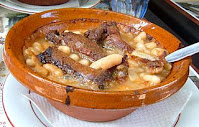I had not heard of it, until my husband and I followed up some links a week ago. He ordered a small (390 g) jar of the stuff for about $20.00 USD. Most of the weight of the jar turns out to be pickling brine; the label helpfully also reports that the "drained weight" is 170g.
The individual pickled walnuts inside are black, shiny black. They appear to be whole walnuts that have been pickled until even the shells are chewable, but that might be a misconception on my part. The taste is sharp, with a hint of sweetness, and no element that resembles walnuts at all. My husband told me after our tasting that he had hoped for an item with a nutty flavor to it. But this pickle could have come from almost any substances soaked in brine for long enough.
The label states, helpfully, "Preserved in a rich, spiced malt vinegar/Tangy and sweet/For finishing cheeseboards and perking up a pie." The walnut I tasted would "perk" up a pie, all right, but I'm not sure that the pie would be best served by the perking!
If any of my readers have experience with walnut pickle (or if they have ever made any) please let me know in the comments.



